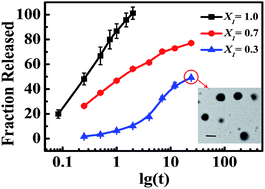Preparation, properties and in vivo pharmacokinetic study of drug vesicles composed of diphenhydramine and AOT†
Abstract
In this work we designed a controlled-release drug delivery system formed by a cationic drug (diphenhydramine hydrochloride, DH) and an anionic surfactant (sodium 2-ethylhexyl sulfosuccinate, AOT) and investigated the corresponding physicochemical properties, aggregation behavior and potential application in drug delivery systems. The DH–AOT mixed solutions with different molar ratios of DH and AOT at the same total concentration were prepared and characterized. The aggregation behaviors of the drug/surfactant solutions were studied by transmission electron microscopy (TEM), dynamic light scattering (DLS), and zeta potential techniques. Furthermore, hemolysis testing, and in vitro and in vivo drug release were studied to evaluate the potential use of the as-prepared catanionic aggregates in drug delivery systems. The results indicate that the physicochemical properties, the hemolytic toxicity and the drug release behavior are dependent on the composition of the samples, X1 (X1 = nDH/n(DH+AOT)). The results demonstrated that these drug-participating catanionic aggregates show potential as an efficient and safe sustained drug delivery system.


 Please wait while we load your content...
Please wait while we load your content...